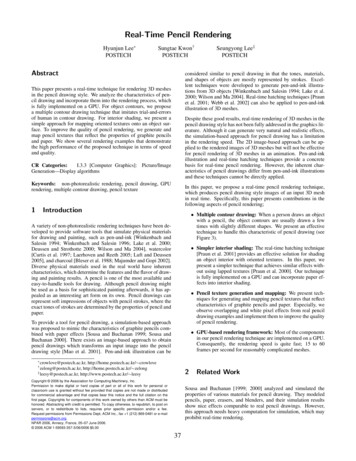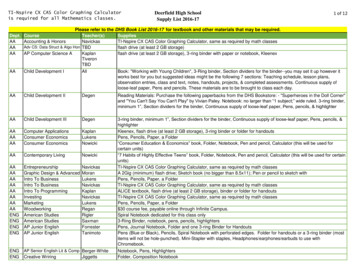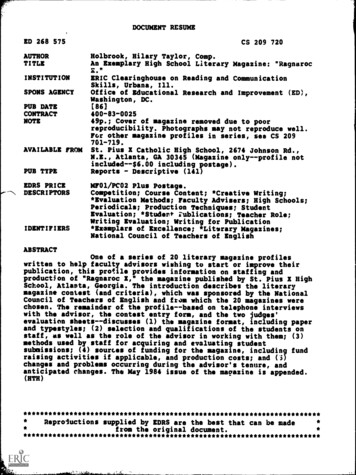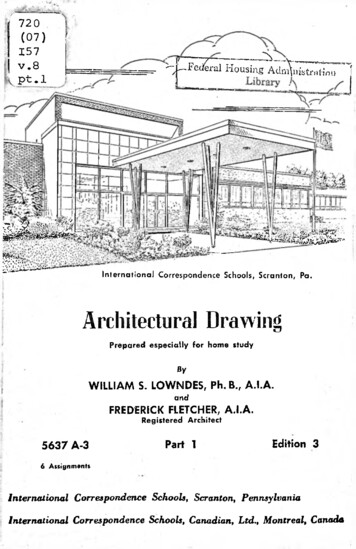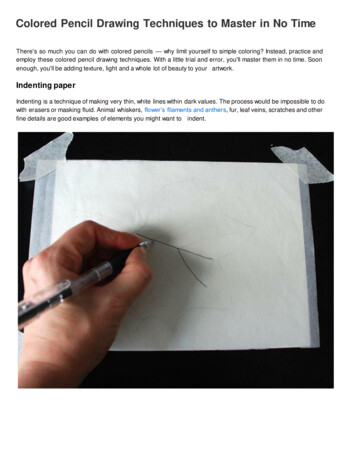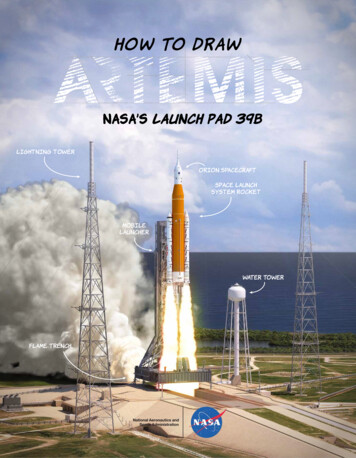
Transcription
Efficient Region-Based Pencil DrawingShuo SunTianjin, 300160China, School of ScienceTianjin Polytechnic UniversitySunshuo 0@163.comDongwei HuangTianjin, 300160China, School of ScienceTianjin Polytechnic Universitytjhuangdw@163.comAbstractThis paper proposes an extension to the existing automatic pencil drawing generation technique based on LineIntegral Convolution (LIC). The original LIC pencil filter utilizes image segmentation and texture directiondetection techniques for defining outlines and stroke directions, and the quality of a resulting image depends largelyon the result of the white noises and the texture directions. It may fail to generate a reasonable result when the whitenoises and the texture directions are not consistent with the texture structure of the input image. To solve thisproblem, we propose in this paper to improve the existed LIC-based method. First, a more accurate and rapid graphbased image segmentation method is introduced to divide the image into different regions. Second, we present anew region-based way to produce white noises and texture directions. We also demonstrate the enhanced LIC pencildrawing is closer to the real artistic style.KeyWord pencil drawing, line integral convolution, image segmentation, Non-photo-realistic renderingapproach is to provide physical simulation to thematerials and skills, and has been mainly combinedwith interactive painting systems or 3D non-photorealistic rendering systems for generating realisticpainterly images. The second approach is the painterlyfiltering, which involves taking an image and applyingsome kind of image processing or filtering techniquesto convert it into an image of a painterly look. Whilemany excellent painterly filtering techniques have beendeveloped for generating brushstroke based paintings[Goo01a], relative few publications can be found onconverting a source image into line stroke baseddrawings. In case of drawing, geometric informationsuch as the outline of regions, the direction and shapeof strokes becomes more critical, while it is usuallydifficult to extract such information from 2D rasterimages automatically. Instead of modeling line strokesgeometrically, Mao etc [Mao01a] have developed apencil drawing filter using Line Integral Convolution(LIC), a texture based flow visualization technique[Cab93a]. The technique utilized the similarity betweenthe appearance of LIC images and pencil strokes, andsucceeded in generating line stroke like images withpixel-by-pixel image filtering. It employs imagesegmentation and texture analysis technique toautomatically detect the outlines and decide the stroke1. IntroductionRecently, Non-Photo-Realistic rendering (NPR)has become one of the most important research topicsof computer graphics. A number of techniques havebeen developed to simulate traditional artistic mediaand styles, such as pen and ink illustration[Win94a,Win96a, Sal94a, Sal97a], graphite and colored pencildrawing[Tak99a, Sou99a, Sou99b], impressioniststyles[Lit97a], paintings of various materials includingoil[Her98a], water color[Cur97a] and so on. Theexisting researches on painterly image generationmainly take two different approaches. The firstPermission to make digital or hard copies of all or part ofthis work for personal or classroom use is granted withoutfee provided that copies are not made or distributed forprofit or commercial advantage and that copies bear thisnotice and the full citation on the first page. To copyotherwise, or republish, to post on servers or to redistributeto lists, requires prior specific permission and/or a fee.Copyright UNION Agency – Science Press, Plzen, CzechRepublic.Full Papers279ISBN 978-80-86943-98-5
orientations for the images. Then for each region, if itcontains directional textures, the texture directions areused as the stroke directions, otherwise a randomlychosen stroke direction is assigned. It may fail togenerate a reasonable result when the white noises andthe texture directions are not consistent with thetexture structure of the input image. To solve thisproblem, we propose in this paper to improve theexisted LIC-based method. First, a more accurate andrapid graph-based image segmentation method isintroduced to divide the image into different regions.Second, we present a new region-based way toproduce white noises and texture directions.We realize automatic generation pencil drawingfrom 2D images. There are several advantages of ourmethod comparing to the existed. First, according tothe characteristics of the pencil drawings produced bythe artists, different areas have different textureexpressions. General speaking, some areas might havevery complicated textures and others might be faint intextures, and that we are desire to achieve this kinds ofartistic effects. Through controlling the noises of thedifferent areas, we can not only express the shade areasof the texture but also hold some subtle area andnecessary blank area in the image. The result is moresimilar to the artistic style.The remainder of this paper is organized as thefollows: Section 2 gives a short survey on related work.Section 3.1 introduces the original LIC-Based pencilfilter method. Section 3.2 describes the algorithmgraph-based image segmentation and Section 3.3-3.4introduces our region-based pencil filter method.Section 4 concludes the paper and gives someexamples.models can be automatically rendered into pencildrawings by referring to the tone value lookup tablefor the parameter values of the models. Takagi andFujishiro proposed to model the paper microstructureand color pigment distribution as 3D volume data anduse volume ray-tracing for rendering color pencildrawings [Tak99a]. Other existing painterly imagegeneration techniques closely related with our workare probably those successful works on pen–and-inkillustrations [Win94a, Win96a, Sal94a, Sal97a]. In theirinteractive systems, pen-and-ink illustrations can begenerated either from 3D models or 2D images byusing a set of pre-stored stroke textures. The largestdifference between our technique and all these existingtechniques is that our technique can generate a pencildrawing from a source image in a completelyautomatic way while all these existing techniques rely,to certain extent, on user interventions, for specifyingthe attributes and directions of strokes. Severalcommercial packages provide some filters for creatingpencil drawing effects. For example, Jasc Paint ShopPro software supports a black pencil filter. However,to obtain a satisfactory result with those filters, a userusually needs to combine the effects of many otherfilters and explore the best generation processexperimentally through trial and error for many times.3. LIC Pencil Filter3.1. LIC AlgorithmLine Integral Convolution (LIC) is a texturebased vector field visualization technique [Cab93a]. Asshown in Figure 1, it takes a 2D vector field and awhite noise image as the input, and generates an imagewhich has been smeared out in the direction of thevector field through the convolution of the white noiseand the low-pass filter kernels defined on the localstreamline of the vector filed.2. Related WorksPencil drawing has been an important topic sincethe beginning of painterly image generation researchhistory. In an early 2D painting system called PencilSketch [Ver89a], a mouse based virtual tablet isprovided for allowing users to interactively specify aset of parameters, such as the hardness of pencil, thepressure applied to a pencil, and the orientations ofstrokes. Recently, Sousa and Buchanan developedseveral pencil drawing rendering techniques based onan observation model of pencil drawings [Sou99a,Sou99b]. They built the models of pencil, paper andhow lead pencils interact with drawing paper through acareful investigation of the real pencil drawings usingscanning electron microscope. When the parameters ofthose models and the strokes are specified, a 2D imagecan be converted into a pencil drawing. 3D polygonFull PapersFigure 1 Line Integral Convolution (LIC) (a) Input vectorfield; (b) Input white noise; (c) Output resultThe images in figure 2 show the basic algorithmof the LIC. The inputs are the vector fields and whitenoises.280ISBN 978-80-86943-98-5
Fig.3: Comparison of a real pencil drawing (a) and an LICtexture (b).3.2. The existed LIC pencil drawing methodFigure 2 the basic algorithm of the LICP is the output pixel,ρ (τ )is stream lineIn general, for producing a pencils drawingfrom a 2D source image, several steps are done. Firstwe generate a white noise from the source image, thenthe original image is divided into different region andthe boundary is extracted. Next we generate the vectorfield representing the orientation of strokes, andproduce pencil drawing by applying LIC to the whitenoise and the vector field. Figure 4 depicts thealgorithm of original LIC pencil filter. It converts a 2Dsource image into a pencil drawing in the followingseven steps:1. Generate a white noise (Figure 4(b)) from the sourceimage (Figure 4(a)).2. Segment the input image (Figure 4(a)) into differentregions (Figure 4(c)).3. Extract region boundary (Figure 4(d)).4. Generate the vector field (Figure 4(e)) representingthe orientation of strokes.5. Generate stroke image (Figure 4(f)) by applying LICto the white noise (Figure 4(b)) and the vector field(Figure 4(e)).6. Add the boundary (Figure 4(d)) to obtain thedrawing with outlines (Figure 4(g)).7. Composite the resulting image (Figure 4(g)) withthe paper sample (Figure 4(h)) to obtain the finishedpencil drawing (Figure 4(i)).( L τ L ),L is the half length of the streamline。 T (ρ (τ )) is the noise texture value in the streamline, K (τ ) is a convolution kernel. So the pixel valuein P is T ′(ρ (0 )) :LT ′(ρ (0 )) k (τ )T (ρ (τ ))dτ LL k (τ )dτ LThe discrete form describes as follows: pi is thediscrete point in the stream line; Wi is the contributionof pi to P, namely the area that K (τ ) cover between pi1 with pi.NT ′(P ) T ( p )Wii 0iN Wi 0iThe idea of using LIC for pencil drawinggeneration was inspired by the visual similarity of LICimages and pencil drawings. As an LIC image isobtained by low-pass filtering a white noise along thelocal streamlines of a vector field, we can observe thetraces of streamlines along which intensity variesrandomly. Such traces have a similar appearance ofpencil strokes where the variance of intensity is causedby the interaction of lead material and the roughness ofpaper surface. Figure 3(a) is a digitized sample of atypical imitative tone used in real pencil drawings.Figure 3(b), presents the very similar features as thetone image by LIC processing.Full Papers281ISBN 978-80-86943-98-5
pixel in the image, the edge set E is constructed byconnecting pairs of pixels that are neighbors in an 8connected sense (any other local neighborhood couldbe used). A weight is associated with each edge basedon some property of the pixels that it connects, such astheir image intensities. Neighbor edges are clusteredinto a forest, and each tree in the forest is related to aminimum spanning tree (MST). Finally each MST is asub-area. To judge whether two trees can be mergedinto one tree, a predicate is defined. The predicateexpression is showed as follow. True: if (Dif(C1, C2 ) MinT(C1, C2 )D(C1, C2 ) False: otherwiseD(C1 , C 2 ) means the merging predicate of theareas of C1 and C2, Dif (C1, C2) means the differencebetween the area C1 and the area C2. MinT (C1, C2) isthe minimum internal difference.The advantage of the method is that the accuracy ofthe image segmentation can be adjusted by users andsome details of the certain regions can be ignored. Thiswill improve on the effect of the pencil drawing. Inaddition, this results in a graph with O(n) edges for nimage pixels, and an overall running time of thesegmentation method of O(n log n) time.Figure4. The existed LIC algorithm (the image comes from[Mao01a])4. Enhanced Region-based LIC PencilFilter4.1. Graph-Based Image SegmentationA well used technique in pencil drawing forconveying the 3D shapes of objects and spatialrelationship among different objects in a scene is toemphasize the boundary between two different regionsby drawing outlines or changing the appearance ofstrokes in the two regions. To create such effect, wepropose to divide the input image into different regionsusing existing image segmentation technique. In ourcurrent implementation, a Graph-Based imagesegmentation technique [Fel04a] is used for the regionextraction. Contrasting to the method in [Mao01a], thismethod can dramatically promote the performance ofour pencil filter. As shown in figure 5, the left image issegmented into many areas which represent therespective color distributions for each region.4.2 Region-based Noise ProductionThe white noise image is generated in a way thatthe probability a white value is set for a pixel isproportional to the intensity level of the correspondingpixel in the input image. The gray-scale tone of aresulting pencil drawing is mainly decided by thewhite noise image. To match the tone between theinput image and the resulting pencil drawing, we usethe tone of the input image to guide the distribution ofnoise.An important characteristic of the pencil drawingis its ability to preserve detail in low-variability imageregions while ignoring detail in high-variabilityregions. The input image is then divided into manysmall regions which have corresponding meanings.The method mentioned in [Mao01a] dealt with thenoise according to uniform criterion. The result noiseswould be failure to distinguish the important elementsand the unimportant elements, when the range of theintensity of the image is small. Our region-basedmethod solves the question through dynamic adjustingthe threshold value of different areas. It is veryimportant to pencil drawing. We simply introduce thealgorithm.Figure 5. Graph-Based image segmentationGraph-based image segmentation techniquesgenerally represent the problem in terms of a graph G (V;E) where each node vi V corresponds to aFull Papers282ISBN 978-80-86943-98-5
Through above method, the noise of each area canbe controlled to match the features of the pencildrawing to a great extent. As shown in figure 6, thepicture (a) show the noise produced by old way, andthe picture (b) is produced by our method. Obviously,the result noise dealt with by our method can reflectthe nature of the pencil drawing. Some areas need tobe emphasized corresponding to more dense noises,and some areas need to be fade out corresponding tosparse noises.Because the processing of LIC is global, so somelocal regions with exquisite texture will be destroyed.In addition to, as a kind of sketch drawing, pencildrawing should keep some blank areas from the pointof aesthetics. So we need to segment the originalimage into different region through above graph-basedmethod, then we deal with the each area throughgiving certain threshold value. Commonly we selectthe average gray intensity of the certain regions as thethreshold values.Our method improves the producing way of whitenoise. We deal with the original gray image accordingto different gray intensity range in the respectiveregions. So the contrasts between light and shade in theresults are more eminent and more similar to theartistic style. The formulation of white noise is showedas follows.Let Iinput be the intensity of a pixel in the inputimage, and P is a floating-point number generated witha pseudo-random function; Ri is the average intensityin the ith regions, and it is selected as the threshold tocontrol the distribution of the noise. Then the intensityInoise of the corresponding pixel in the noise image isdecided in the following way: max1: (if (P T1 ))(if (Input Ri )) Inoise1 min1: (else)Inoise (P [0,1]) max2 : (if (P T2 )) I(if (Input Ri )) noise2 min2 : (else) (a)Here max1 and max2 are the maximum grayvalues of the output pixels, which usually are 255; andmin1 and min2 are the minimum gray values of theoutput pixels, which usually are Ri. However, we canadapt these values to fit for the whole tone of thepencil drawing.T1 k i ,1 (1 I inputk i ,1 λ 1 (1 255I input255), T 2 k i , 2 (1 ), k i , 2 λ 2 (1 I input255I input255(b)Figure 6 The existed noise algorithm (a), andRegion-Based noise method (b).4.3.Stroke OrientationWhen using imitative tone, the direction ofstrokes is an important factor contributing to theimpression of a pencil drawing. The stroke direction isalso important for conveying the shapes and textures ofobjects. If a texture presents a directional feature, thenstrokes should be oriented in a direction matching thatof the original texture. For example, when we painthuman hair, we would have our pencil follow thedirection of hair strands. To produce such effect, Maoetc [Mao01a] implemented a Fourier texture analysistechnique for extracting the local texture directions.The basic principle of the technique is that if a texturepresents a specific direction, then after transform thetexture into frequency domain, the power spectrumshould have large values in the direction orthogonal tothe direction of the texture. They deal with each pixel))λ 1 , λ 2 [ 0 ,1]According to our method, λ1 and λ2 are twoexperiential values. Our initial experiment resultsuggests that a default value of 0.7 and 0.3 produce avisually acceptable result for most scenes. We alsoallow users to interactively adjust the values of λ1and λ2 .Full Papers283ISBN 978-80-86943-98-5
in the input image and compute respective texturedirection by the analysis of the FFT.The method mentioned above is very timeconsuming, and they don’t consider the local structurefeatures of the image. Usually, some regions havesimilar directions of the strokes, and these areas can bedealt with the uniform direction according to artisticstyle. On the other hand, the directions of the strokesvary dramatically in some regions, so we keep theresults of the respective directions, and then the detailsfeatures in the area should be represented. As shown infigure 7, the direction of hair strands is important in (a)and the details of the cloud should be depicted in (b).miDi (Vi , j Vi ) 2j 0The final field vector of the each pixel isdetermined through the following criterions: Vi , j : if ( Di / mi T )FVi , j Vi : (else)Here T is a given threshold. Experiments suggestthat a default value of 0.7 produce a visuallyacceptable result for most scenes.(a)(a)Figure 7 the direction of hair strands (a), and the details ofthe cloud (b).(b)Here we propose a method to produce thedirection of the stroke according to the features in theregions. First, the orientation vectors of the pixels arecalculated by sobel operator. Then a criterion ispresented to decide the direction of the stroke.Let Vi , j ( j 0 ,1, 2 ,. m i ) be the field vector ofthe jth pixel in the ith area. It is computed by sobeloperator. Here m j is the numbers of the pixels in thejth area.Then the mean of the field vectors in each area iscalculated. At the same time, the CV (Coefficient ofVariation) is computed to reflect the orientation’sdistribution.(c)Figure 8. The contrasts of the stroke directionsmiFigure 8 (a) is original image, and (b) is the resultin [Mao01a]. The picture (c) is our result. Obviously,Vi ( Vi , j ) / mij 0Full Papers284ISBN 978-80-86943-98-5
our result not only reflects the details in some areas butalso embody the style of the pencil drawing.5. Experiment resultsWe have implemented all the techniquesdescribed above and built an automatic pencildrawinggeneratingsystemonWindowsenvironment. Basically, after the input image isspecified, a pencil drawing style image will begenerated automatically with a set of default valueand other information derived by the system fromthe input image. Users are also allowed tointeractively specify some parameters, such as theparameters for controlling the region tone of theoutput image, the threshold used for graph-basedimage segmentation and the length of convolution.Comparing to the existing method in [Mao01a], thenew algorithm is much faster than the existing one andmore similar with the artistic style of the pencildrawing. The existing LIC pencil filter took about 60seconds to generate an image of size 350*280 on aPentium IV PC. Our method only require about 5seconds. For an image of size 1024*768, our methodtakes about 20 second, and the more important featurecontrasting to the method in [Mao01a] is that ourmethod dynamically analyzes the texture structure ofthe regions. So it is effective and lifelike. Severalresults of the pencil drawing as shown in figure 9.Figure 9. Several results of the pencil drawing6. ConclusionWe propose in this paper to improve the existedLIC-based method. First, a more accurate and rapidgraph-based image segmentation method is introducedto divide the image into different regions. Second, wepresent a new region-based way to produce whitenoises and texture directions. The new algorithm ismuch faster than the existing one and more similarwith the artistic style of the pencil drawing. Webelieve the purpose of NPR systems is not to replaceartists, but rather to provide a tool for users with notraining in a particular medium. Potentialapplication fields of our technique includeproducing posters from photo graphs, processingvideos into pencil drawing style animations,obtaining the preparatory sketches for creatingpaintings of other styles, and so on.Full Papers285ISBN 978-80-86943-98-5
Pacific Graphics'99 conference proceedings, page 250258, 1999.[Tam84] H. Tamura Edited, “Introduction to ComputerImage Processing (In Japanese)”, Soken ShuppanPublisher Inc. 1984, ISBN4-7952-6304-3.[Ver89a] A. H. Vermeulen and P. P. Tanner, “Pencilsketch―A Pencil-Based Paint System”, GraphicsInterface '8.,1989[Win94a] G. Winkerbach, D. H. Salesin, “ComputerGenerated Pen-and-Ink Illustration”, SIGGRAPH94conference proceedings, pages 91-100, 1994.[Win96a] G. Winkenbach and D. H, Salesin, “RenderingParametric Surfaces in Pen and Ink”, SIGGRAPH96conference proceedings, pages 469–476, 1996.The major future research directions include therealization of abstraction and focusing, establishmentof the curved strokes, extension to colored pencildrawing and application to non-photorealisticrendering of 3D models and scenes.7. AcknowledgementsThe work reported in this article is supported by theNational Natural Science Foundation of China(No.10472077, No.50375107).8. References[Cab93a] B. Cabral and C. Leedom, “Imaging Vector FieldUsing Line Integral Convolution”, SIGGRAPH93conference Proceeding, pages 263-270, 1993.[Cur97a] C. J. Curtis, S. E. Anderson, J. E. Seims, Kurt W.Fleischer, and David H. Salesin, “Computer-GeneratedWatercolor”, SIGGRAPH 97 conference proceedings,pages 421–430, 1997.[Fel04a] P.F. Felzenszwalb, D.P. Huttenlocher “EfficientGraph-Based Image Degmentation” InternationalJournal of Computer Vision[J], 2004[Goo01a] Gooch, Non-Photorealistic Rendering, AK PetersLtd, 2001.[Her98a] A. Hertzmann, “Painterly Rendering with CurvedBrush Strokes of Multiple Sizes”, SIGGRAPH 98conference proceedings, pages 453–460, 1998.[Lit97a] P. Litwinowicz, “Processing Images and Video forAn Impressionist Effect”, SIGGRAPH97 conferenceproceedings, pp.407-414, 1997.[Mao01a] X. Mao, Y. Nagasaka and A. Imamiya",Automatic Generation of Pencil Drawing from 2DImages Using Line Integral Convolution", Proceedings ofthe Seventh International Conference on Computer AidedDesign and Computer Graphics CAD/GRAPHICS2001,PP. 240-248, 2001. conference proceedings, pages 138143 , 1989.[Sal94a] M.P. Salisbury, S. E. Anderson, R. Barzel, and D.H. Salesin, “Interactive Pen–And–Ink Illustration”,SIGGRAPH 94 conference proceedings, pages 101–108,1994.[Sal97a] M. P. Salisbury, M. T. Wong, J. F. Hughes, and D.H. Salesin, “Orientable Textures for Image-Based Penand-Ink Illustration”, SIGGRAPH 97 ConferenceProceedings, pages 401–406, 1997.[Sou99a] M.C.Sousa and J.W.Buchanan, “ObservationalModel of Blenders and Erasers in Computer-GeneratedPencil Rendering”, Graphics Interface '99 conferenceproceedings, pages 157-166, 1999.[Sou99b] M.C.Sousa and J.W.Buchanan, “ComputerGenerated Graphite Pencil Rendering of 3D PolygonalModels”,EUROGRAPHICS '99 conference proceedings,pages 195-207, 1999.[Tak99a] S. Takagi, I. Fujishiro and M. Nakajima,“Volumetric modeling of colored pencil drawing,”Full Papers286ISBN 978-80-86943-98-5
produce pencil drawing by applying LIC to the white noise and the vector field. Figure 4 depicts the algorithm of original LIC pencil filter. It converts a 2D source image into a pencil drawing in the followi

